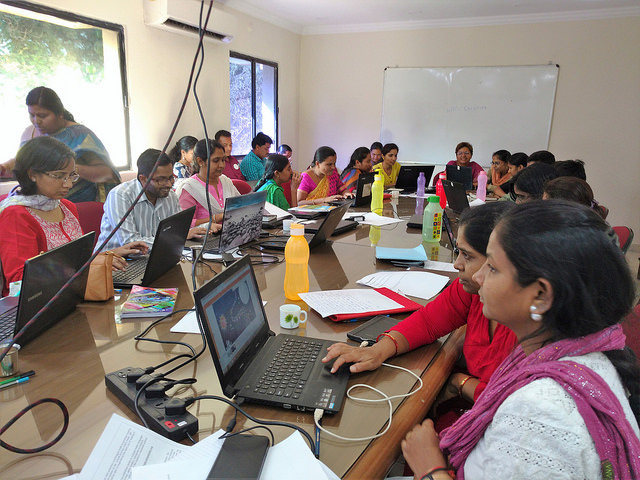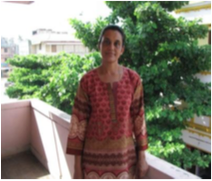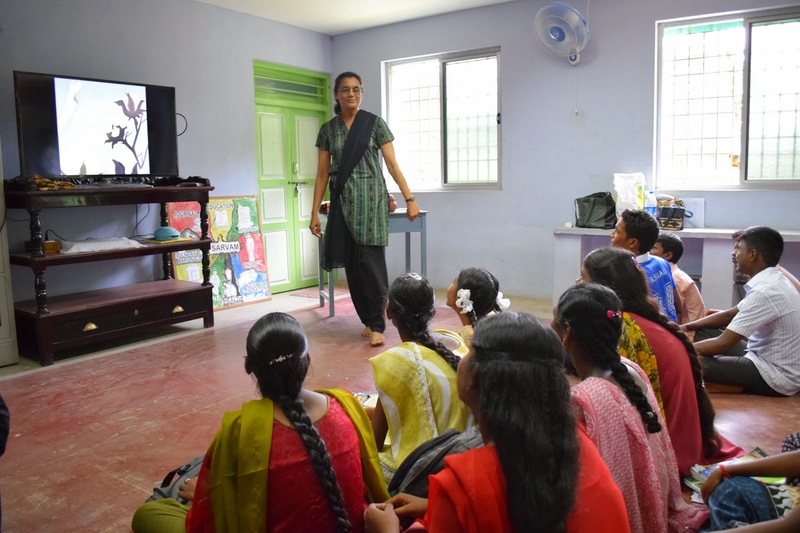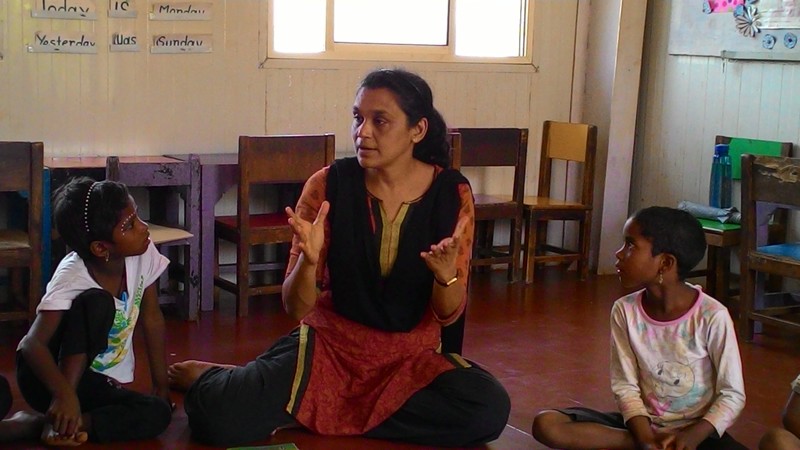StoryWeaver Visits Hyderabad!
Posted by Sherein Bansal on June 08, 2017My first StoryWeaver workshop took me to Hyderabad. I was officially on the training side of the workshop, but since this was my first, I experienced those two days with two different batches as a participant too.
50+ educators, resource people, librarians and program managers from 12 different organisations and schools poured into the room and were brimming with energy even before the workshop began. Payoshni, Senior Outreach Manager and trainer for the workshop, talked about StoryWeaver - our open repository of free children’s books, its practical uses in a classroom, and the way it can be used to enhance a child’s world from all aspects like cognitive approach, social skills, comprehension, logical thinking and aesthetics.

Teachers became curious students and asked us countless questions that spanned across queries about our features, to the efficacy of the platform itself. It was a delight to see them realize the applications of StoryWeaver in the classroom. Once they understood the intricacies of creating, translating or releveling (simplifying or making a story complex) stories on the platform, all of them were eager to try their hand at bringing about their own creation on StoryWeaver.
Sandhya Damodar, Pudami Schools, Hyderabad talks here about the various applications of StoryWeaver in a classroom and specifically the advantages of being able to ‘relevel’ stories:
The fact that the stories on StoryWeaver are free to use, read, download and print was exciting and important for teachers who came from schools based in rural settings. Active discussions ranged from how to preserve the accuracy and sanctity of a language through translations. Concerns unfolded about how some languages need more original content for the children, and one way could be to create and translate in that language on platforms like StoryWeaver.
In this short video, workshop participant Shadab Ahmad, Focus High School, Hyderabad talks about how StoryWeaver will help him in getting Urdu stories across to his students and also about the ease of publishing good stories on the platform.
The childlike joy of the teachers working in teams with fellow educators whom they didn’t know previously, and raising their hands to read their created stories out loud was infectious. They proudly presented their work in front of everyone and laughed along with everyone at the bits they got wrong or where they themselves had added humor! Some of them are still active on the platform and creating/translating/releveling stories for their students, for fun, or to contribute in some way to their favorite language.
As we wrapped up the two-day workshop, it was a comfort to know there are educators who are eager to learn about how to improve a child’s experience in classrooms. And not just that, they want to do it through the art of stories.
Here are a few pictures from the event!
A big thank you to Dr.Reddy’s Foundation who made this wonderful workshop possible and all their efforts in bringing the best opportunities to their children. If you are interested in hosting a similar workshop for your organisation, drop us an email on [email protected].
Meet Team4Tech
Posted by Remya Padmadas on March 30, 2017The idea for Team4Tech was born in 2012, when Julie Clugage and Lila Ibrahim, witnessed the “transformative power of education”: Julie worked in a school in rural Guatemala while Lila worked in an orphanage in Lebanon. After working closely for years at Intel Corporation, to advance education and economic development through technology, they launched the Intel Education Service Corps in 2009. This program was met with incredible support as a large number of Intel employees began volunteering their time and expertise to the improvement of education.
In September 2012, they had another idea: creating a platform accessible to talented professionals from a variety of technological companies, to improve the quality of education around the world. With this in mind, in May 2013, they launched their first project in Kenya with a total of nine volunteers. The plan was to introduce an adaptive learning software solution to increase the education level of the primary school children. Within six months of this implementation, the students had doubled their literacy test scores. Since this project, Team4Tech has engaged in many similar projects, broadening their impact on education standards. One such project was run in November, 2016, in Hardoi, Uttar Pradesh by Dawn Kwan, the project manager for Team4Tech.
VMware and Udaan Mewat Teachers
She led a project with CARE India's Udaan Mewat school where a team of VMware employees brought technology to augment the teaching and learning objectives for a residential bridge-building school for girls, who had previously dropped out of school. Udaan Mewat is an innovative 11-month program where a group of 80 girls complete Grades 1 - 5 through innovative teaching methods, and continue their studies in government schools. After 5 weeks of preparation, the VMware volunteers spent a week in Mewat, showing the teachers how to use the technology provided - building long term sustainability of the equipment.
One of the tools used in this program was Pratham Books' StoryWeaver. Dawn taught three of CARE India’s master trainers, who work with government lower and upper primary school teachers (giving them a reach of over 1000 teachers and 50,000 students), how to use StoryWeaver. She reported that they “loved StoryWeaver's wealth of stories, the ability to translate and the ease of creating new stories.”
CARE India trainers learning about StoryWeaver
She also shared Varseena's story with us. A student in the first batch who had graduated from Udaan Mewat, Varseena learned how to use StoryWeaver. “She's extremely bright and created a story, and taught her story to the rest of the Udaan students”. Varseena will play a continuous role in the implementation of StoryWeaver since she was asked to teach the teachers how to use the platform. On the last day, one of the teachers even used a downloaded Pratham Books story in her class.
Team4Tech has clearly made a lot of progress in bettering the education system all over the world through their programs and outreach. The existence of platforms like StoryWeaver and KA Lite (an offline version of Khan Academy - also used by Team4Tech) makes this job easier and more fun for the students. The technological aspect of this is what excites people the most and, in a world where electronic devices have taken over lives, introducing education via technology engages the audience more than anything else. This is why, although few in number, organisations like Team4Tech are successful in completing their goals.
Be the first to comment.Using Stories to Enhance Language and Literacy Skills
Posted by Remya Padmadas on March 29, 2016

Nabanita Deshmukh is a teacher, a teacher educator, and a writer of children’s stories and poems. She had been a consultant at Azim Premji Foundation, Pondicherry and has worked with government school teachers on interactive methods of teaching. Nabanita has been instrumental in introducing Stories and Language Games as a means for developing language skills in primary level children. She has also conducted workshops for teachers and students in Odisha, Pondicherry, Kerala and Arunachal Pradesh on creative writing, storytelling and classroom games and other alternate modes of classroom teaching such as the use of magazines for the improvement of English. She conducts teacher interactions on motivation and classroom management.
She contributes stories and articles to magazines and publishing houses like Chandamama, Bal Vihar, Children’s World, Children’s Choice, Children’s Digest, Pratham Books and Matrubhumi.
You can read her books 'Why Do Bees Buzz?' and 'Why Can't We Glow Like Fireflies?' on StoryWeaver.
I am just back from a long teacher training tour in Chattisgarh and western Odisha. The main focus of the workshops was the enhancement of language and literacy skills through interactive modes such as stories, poems, skits and songs. In this context Pratham's Adi Kahani series and the online Storyweaver platform came in handy.
STORYWEAVER
Stories from this portal were shown to a group of primary school teachers and teacher educators from various states of India. Here is an example of how one of the presentations took place. The session went through three stages: pre-viewing, while-viewing and post-viewing. The 'First House' story was chosen for the demo.
In the pre-viewing stage, I first showed the cover page to the participants and they all had to guess what the story was all about and where it was set. This pushed the teachers to observe the illustrations and the printed details carefully. Later they guessed that the story took place in a forest and it was about two tribal men.
Pre-reading or pre-viewing stages always help break the ice and familiarise readers with unfamiliar settings, characters and vocabulary. If teachers used prediction like I had done with the cover page of the book, students would surely show more interest in reading a story.
In the while-reading stage, I projected the first page of the book and asked the following questions:
1. In which state of India do you think this story is taking place?
2. Which creatures do the characters meet when they come out of the cave?
3. What advice do these creatures give them? (Answers to be given using direct speech)
4. What kind of house do you think the characters built eventually? (Description)
These questions were asked to help participants use communicative English (Q-3), imaginative skills (Q-2&4), logic (Q-3) and geographical knowledge (Q-1)
After getting the answers from the participants, the entire story was projected on screen and the participants enjoyed reading it. They also loved the colourful illustrations and the different options the story presented. I finally read out the paragraph on the Singpho tribe printed at the end of the book and made the teachers use atlases to locate Arunachal Pradesh and its physical features on the map.
Some teachers even attempted to translate the first few lines of the story in their own mother tongue-Kannada, Tamil, Bengali and Chattisgarhi.


ADI KAHANI SERIES
The Adi Kahani stories in the Kui language were used in Odisha with primary school teachers who taught children of the Munda tribe. This tribe speaks the Ho language. Despite not knowing Kui, the tribal and the non-tribal teachers reacted favourably to the stories. For example in the stories of the fox and the pitcher and also in the fox and the chicken, the teachers appreciated the use of local settings, objects and characters. They thought these would help children understand the story better as the surrounding is familiar-rivers, foxes, cowherds, women carrying wood, earthen pots are all so familiar to village children no matter to which tribe they belong to!
The story of how the rabbit got its long ears became an instant favourite among Munda teachers and many felt the folktale could be made into a skit.
It was a great experience using Pratham Books and the Storyweaver platform during my training. More Odia translations of stories and Munda tribe folktales written in English and then translated into different languages will be most useful. I just came to know that the Ho language has a script. Heartening, isn't it?
Be the first to comment.